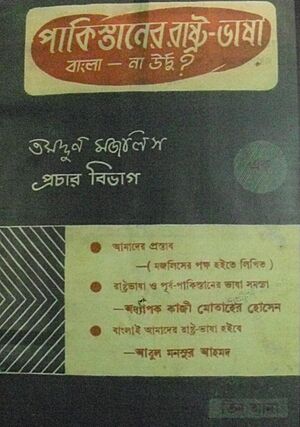Tamaddun Majlish facts for kids

"Pakistan's state language: Bengali or Urdu?" - The cover of a Tamaddun Majlish newsletter
|
|
| Formation | September 2, 1947 |
|---|---|
| Founder | Principal Abul Kashem |
| Headquarters | Moghbazar, Dhaka, Bangladesh |
The Tamaddun Majlish (Bengali: তমদ্দুন মজলিশ) is an important cultural group in Bangladesh. It was started in 1947 by Principal Abul Kashem. This group played a big part in the early days of the Bengali Language Movement. This movement was about making Bengali an official language.
Contents
How Tamaddun Majlish Started
Tamaddun Majlish was formed in Dhaka on September 2, 1947. This was right after India was divided into two countries, India and Pakistan. Principal Abul Kashem, a professor at Dhaka University, founded the group. From the very beginning, it was very active. It helped kick-start the Bengali Language Movement.
Many members of Tamaddun Majlish were inspired by the ideas of the East Pakistan Renaissance Society. After the division of India, they felt that Pakistan was not following the ideals it had promised. Because of this, most members of Tamaddun Majlish started to move away from the Muslim League political party.
Tamaddun Majlish and the Language Movement
The main goal of Tamaddun Majlish was to strengthen Islamic culture in the new country of Pakistan. However, this group also strongly supported the Bengali-speaking people of East Pakistan. They showed that the demand for Bengali to be a state language was not against the country. It was a fair request from the people.
On September 15, 1947, Tamaddun Majlish released a special booklet. It was called Pakistaner Rashtra Bhasha: Bangla Na Urdu? This means "Pakistan's State Language: Bengali or Urdu?". Important writers like Kazi Motahar Hossain, Abul Mansur Ahmed, and Principal Abul Kashem wrote it. They argued strongly that Bengali should be the main language for schools, offices, and courts in East Bengal. They also demanded that Bengali be one of Pakistan's official state languages.
The booklet had a clear plan from Principal Abul Kashem. Here are the main points:
- Bengali should be:
- the language used for teaching in East Pakistan;
- the language used in courts in East Pakistan; and
- the official language of East Pakistan.
- Urdu and Bengali should both be official languages for Pakistan's central government.
- Bengali should be the first language taught in schools in East Pakistan. Everyone should learn it.
- Urdu could be a second language in East Pakistan. It would be for people who might work in West Pakistan. Only a small part of the population (5% to 10%) would need to learn Urdu. It could be taught in higher grades of secondary school.
- English should be the third language. It would be used for international communication.
- Both English and Bengali should be used as official languages in East Pakistan for a few years.
To fight against the government's policies that were against Bengali, Tamaddun Majlish took action. They protested comments made by Fazlur Rahman, the Central Education Minister. In October 1947, Tamaddun Majlish led the creation of the first Rastrabhasa Sangram Parishad. This means "State Language Movement Council."
Nurul Huque Bhuyain of Dhaka University became the leader of this first council. However, Abul Kashem, the general secretary of Tamaddun Majlish, was key in the early stages. He gathered wide support for making Bengali a state language. He successfully involved young people, especially teachers and students from Dhaka University. This council gave the language movement the organization it needed in late 1947 and early 1948.
The first protest meeting happened at Dhaka University on December 6, 1947. It was organized by the Rastrabhasa Sangram Parishad. People were protesting a decision made in Karachi to make Urdu the only state language of Pakistan. Many students, teachers, and others from Dhaka University attended. Abul Kashem led the meeting. Several students and teachers spoke, including Munir Choudhury and Farid Ahmed.
The ideas of Tamaddun Majlish about the Bengali Language Movement matched what the common people of East Bengal wanted.
Weekly Shainik
From 1948 to 1961, Tamaddun Majlish published a weekly newspaper called Shaptahik Shainik. This newspaper was like the voice of the Bengali Language Movement.
Important Members
Some important people who were members of Tamaddun Majlish include:
- Principal Abul Kashem
- Abul Hashim
- Dewan Mohammad Azraf
- Shahed Ali
- Nurul Huq Bhuiyan
- Shawkat Ali
- Kabi M.A.N Shahidullah shahittarotno
- Abdul Gafur
- Sanaullah Nuri
- Golam e Azam

